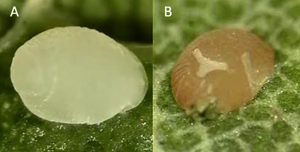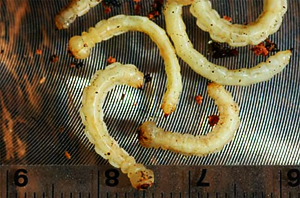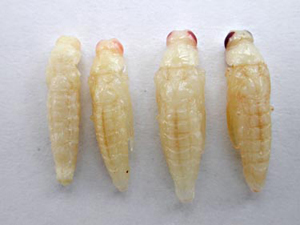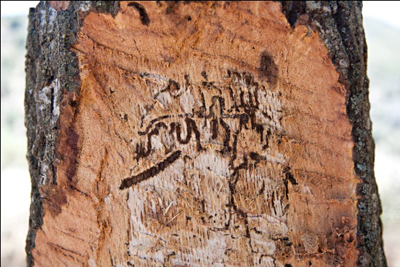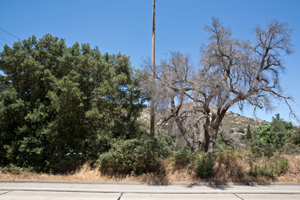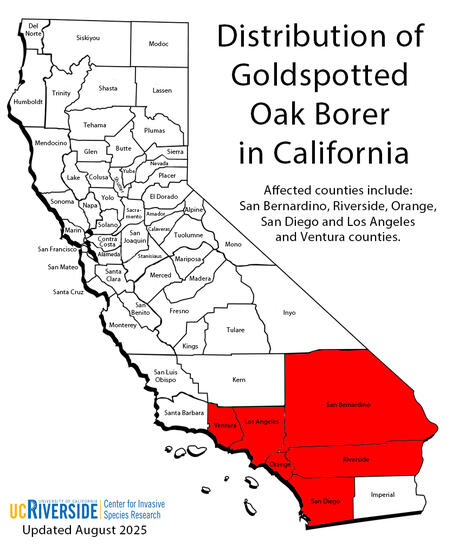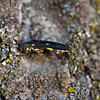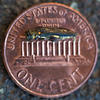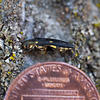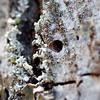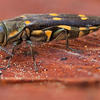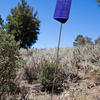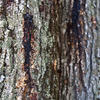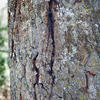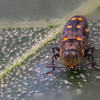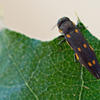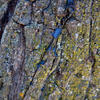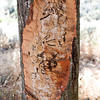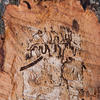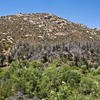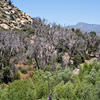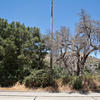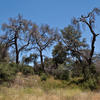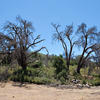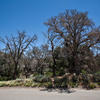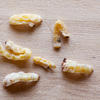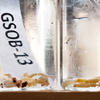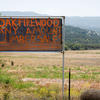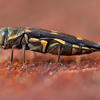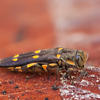The Goldspotted Oak Borer (Agrilus auroguttatus) Schaeffer (Coleoptera: Buprestidae)
Overview
The Goldspotted Oak Borer (GSOB) is a buprestid beetle which is native to oak forests of Southeastern Arizona, and a closely related species (Agrilus coxalis), almost identical in appearance, is found in Central Mexico, and Northern Guatemala. Since 2002, GSOB has contributed to the mortality of more than 80,000 trees over approximately 4,900 km2, and this infested area continues to increase as the GSOB population grows and spreads. In its native range, GSOB is not a pest. This may be due to efficient population control by natural enemies and natural levels of resistance by oak species that have co-evolved with GSOB.
GSOB was first detected in San Diego County, California in 2004 by the California Department of Food and Agriculture during a survey for exotic woodborers. Four years later (2008), it was found attacking three species of oak in the Cleveland National Forest in San Diego county: coast live oak (Quercus agrifolia), canyon live oak (Q. chrysolepis), and California black oak (Q. kelloggii). Photos of these three oak species are shown in figures 1, 2, and 3 respectively.
Oak trees are classified into three categories which include white oaks, red oaks and intermediate oaks. These categories characterize three evolutionary lineages in Quercus, and are separated by their types of leaves, acorns, bark and wood. For example, white oaks have light grey or brown bark, while red oaks have dark grey, blackish or brown bark. White oaks also have light brown or yellowish wood while red oaks have reddish wood. Intermediate oaks are typically transitional, having intermediate qualities, or those more like either the white or red oaks. GSOB seems to prefer red oaks, although it will occasionally feed on intermediate oaks, and almost never on white oaks.
Although elevated levels of oak mortality had been aerially mapped by the USDA Forest Service in the Cleveland National Forest since 2002, it was not known that GSOB was the cause of such mortality until 2008 when it was officially confirmed as the primary mortality agent. The general belief until this time was that drought was the main contributing factor to the loss of so many oaks.
Distribution
Museum records from southeastern Arizona (A. auroguttatus), southern Mexico, and northern Guatemala (A. coxalis) indicated that GSOB has been collected from these areas since the late 1800's and these regions collectively form the native range of the evolutionary area of origin for the two species of GSOB. GSOB was first collected in California in 2004, suggesting a possible range expansion, because this attractive beetle had not been previously found in this state despite a long history of active survey work by professional and amateur entomologists. Although the presence of GSOB in southern California could reflect a natural unassisted range expansion by native populations to the east and south, it is more likely that GSOB was introduced during the last ten years in oak firewood that originated from areas where this beetle is native (perhaps somewhere in Arizona).
Impacts
GSOB is responsible for major oak mortality on federal, state, private, and Native American lands in southern California. Since GSOB’s invasion into southern California, there have been many negative effects resulting from GSOB-induced oak mortality to both private and public lands which are now being assessed and quantified. In addition to dying oaks, another major negative effect is monetary cost. Economic costs are due to the direct loss of valuable oak trees, especially landscape or heritage trees due to GSOB infestation, increased pest management (monitoring and control) and forest management costs (removal of dead trees that can fuel wildfires), and emergency response costs (removal of hazardous trees in public areas). For example, according to the 2010 Forest Service Forest Health Protection (FHP) Individual Pest Risk Assessment report, between 2008 and 2010 Cuyamaca Rancho State Park spent $52,600, in addition to 1,300 person hours, removing hazardous oaks throughout the park. Several campsites were also closed due to hazard tree concerns attributed to GSOB resulting in a more than $400,000 loss of camping revenue and day use fees. Finally, there is the cost due to the loss in property value. Previous studies suggest that oaks contribute from 5 to 30% of the appraised values of real estate. Therefore, towns such as Julian and Ramona, which are dominated by GSOB infested oak woodlands, are being significantly impacted by losses in property values. If affected property owners want to maintain their home values, they will have to replace their dead oaks which can cost thousands of dollars per replaced tree, or commence regular and costly pesticide applications to kill GSOB infestations to reduce the likelihood of future attacks. To give an example of this cost, a 20yr old coast live oak tree costs approximately $6000. If you break that down, that’s about $300 for each year the tree is alive. And, since the oak trees that are being killed by GSOB are typically very old (usually hundreds of years old), we can estimate that the cost of a one hundred year old tree to be approximately $30,000, which is a very conservative estimate.
Since oaks are keystone species in southern California’s woodlands, their widespread loss is also causing detrimental impacts to the natural landscape of this area. Biodiversity is adversely affected due to the loss of habitat and food resources used by native animals such as acorn woodpeckers, mule deer, ground squirrels, and the arroyo toad. Shading of sensitive riparian areas is being reduced which threatens water supplies and the existence of animals and plants that rely on this scarce resource. Also, increasing numbers of dead oaks are significantly increasing the fuel load in these areas, which can increase the probability and severity of wildfires in these natural areas. And lastly, there is a cost associated with the loss of aesthetic value because large swaths of dead oaks are ugly to look at and the attractiveness of these afflicted areas for hikers, photographers, and tourists is greatly diminished. Although this cost is difficult to estimate, it is nevertheless present, and possibly quite high.
Identification
GSOB eggs are about 1 mm in width and are oval shaped with a flat bottom (Fig.4). They are white when first laid, but turn a brownish color within 2-3 days, and hatch within 10-14 days. In the lab, eggs have been observed to be laid individually on both artificial surfaces (e.g., paper coffee filters) and in oak bark crevices. Eggs have not been observed in the field because they are so small and difficult to find, but they are probably laid in bark crevices like other Agrilus species.
Biology
Mature larvae are about 18 mm long and 3 mm wide (Fig 5). They are legless, white, and have a long slender appearance. Larvae
have a bulbous head with hardened mandibles which are used for boring into bark and phloem, and they possess two pincher-like spines at the tip of the abdomen. This is a very important and characteristic feature that separates GSOB larvae from other beetle larvae (e.g., cerambycids) that may also be found feeding inside oaks.
GSOB adults feed on oak foliage, where they likely mate. Females probably lay eggs in cracks and crevices of oak bark. Although this has not been observed in the field, it has been seen in the laboratory. Once eggs hatch, larvae burrow into the tree where they feed under the bark, primarily at the interface of the sapwood and phloem, a zone known asthe cambium.
The cambium layer is a thin layer of generative tissue lying between the bark and the wood of a tree trunk. The cambium produces new layers of phloem on the outside and of xylem (wood) on the inside, thus increasing the diameter of the trunk. Feeding in this zone is concentrated in the lower parts of the main trunk and it is thought that larger branches may also be affected when GSOB populations are very high in trees. Feeding larvae kill patches of cambium, which eventually causes tree death when the trunk is heavily attacked in this manner. Removal of bark to reveal the cambium layer shows that larval GSOB feeding galleries are dark in color and have a meandering orientation (Fig. 8). Once the larvae are mature, they will tunnel to the underside of the bark where they will pupate before reaching adulthood. When adult development is complete, the adults chew an emergence hole through the bark and exit the tree.
In southern California, initial observations suggest that most of the GSOB population completes one generation each year with mature larvae present in trees beginning in late May. Larvae and pupae have been observed beneath bark as late as October, suggesting that some small fraction of the population may require more than one year to develop. Preliminary flight trapping suggest that adult activity occurs from June to September with peak flight in late June. Attacks from GSOB have been observed generally in older, mature oaks (typically > 20cm diameter). However, GSOB attacks have infrequently been observed in small diameter oaks (< 12 cm at breast height). Additional research is needed to clarify the life history parameters (e.g., developmental rates at varying temperatures and with different oak hosts as food) and host range of GSOB. Due to host distribution, GSOB has the potential to spread north in California and cause similar tree mortality. Some of the potential northern California hosts for GSOB include black oak, coast live oak, interior live oak, and island scrub oak. These oaks are within the red oak category, which is the preferred host group for GSOB. Since very little published information is available on this insect, additional research is needed to better understand the life cycle of this pest, reproductive and host tree selection behaviors, and management strategies, especially biological control with natural enemies from the home range of GSOB.
Evidence of Attack
The ability to accurately and quickly identify infested oak trees is extremely important because it will aid in tracking the GSOB’s movement throughout California. This is especially important for areas which are outside of the known range of infestation, because the earlier outlying GSOB populations are identified, the possibilities of stopping or slowing potential future spread from these new foci is greatly increased.
To determine whether an oak is infested by the GSOB, there are four major symptoms to look for. The first and most obvious is crown thinning. Patch-killed regions caused by GSOB larvae are commonly saturated with sap, which initiates premature leaf drop and progresses to twig and branch die back. The Forest Service FHP has created a rating system which ranks tree health according to tree crown thinning (or lack thereof). The rating system ranks the trees on a scale from 1-5 with 1 being a very healthy, probably uninfested tree, and 5 being a dead tree. In figure 9, the extremes of this rating system are shown
side-by-side. On the left is a tree with a rank of 1 because it is a healthy tree with a full and complete crown, and it shows no sign of crown thinning or dieback. On the right is a dead tree which has been given a rank of 5. Ranks two, three, and four are represent intermediate levels of crown dieback where rank two has minor twig dieback and ~25% leaf loss. Rank three has moderate crown thinning and ~50% leaf loss. Finally, rank four has severe crown thinning and ~75% leaf loss.
Crown thinning may become evident after two to three years of attack. However, it is important to keep in mind that California black oak is deciduous and it naturally looses foliage during colder months. Crown thinning is easily detected from a distance, so if crown thinning is observed, the tree in question should be looked at closely to determine if three other symptoms associated with GSOB attack are present. These additional symptoms are exit holes made by adult beetles leaving the tree after they have completed pupation, bark staining, and woodpecker damage.
GSOB exit holes are typically D-shaped and are about 3mm in width (Fig. 10). These emergence holes are chewed by adult GSOB that are exiting pupal chambers just beneath the surface of the bark. The presence of adult exit holes indicates GSOB activity has occurred in that particular area of the tree.
Collectively, the presence of GSOB larvae and their galleries, adult emergence holes, bark staining, and associated woodpecker damage distinguish oaks infested GSOB from trees not suffering detectable GSOB attack.
Management Options
Several Agrilus spp. in the U.S., including bronze birch borer, emerald ash borer, soapberry borer, and twolined chestnut borer, have very similar life histories and impacts on hardwood trees. Until management guidelines can be developed specifically for GSOB, arborists, land managers, forest health specialists, and homeowners may want consider the following information from other hardwood Agrilus spp. when managing oaks for GSOB. These management tactics have not been tested for GSOB in southern California.
Logs and firewood from GSOB-killed trees or green infested trees should not be moved from infested areas into new areas, because these new locations may lack GSOB and the movement of infested wood may introduce this pest into new areas where it does not exist. Transporting GSOB infested oak firewood is probably a significant and important pathway for introducing GSOB into non-infested areas. Removing dead or dying trees infested with GSOB followed by careful handling of infested materials may reduce localized populations. Within infested areas, covering oak wood with thick, clear plastic sheeting or exposing cut wood to direct sunlight may kill GSOB larvae and pupae. Covering oak wood with plastic sheeting is much more effective than directly exposing wood to sunlight because the sheeting will trap any adults that might emerge from the infested wood. Without food and because the plastic elevates temperatures, these trapped adults will die. It is important to make sure that the plastic cover is tightly sealed to the ground and does not have holes from which beetles could escape. Chipping wood into 2.5 cm pieces is the best method to drastically reduce Agrilus spp. survival in cut logs. Some insecticides are being evaluated for their ability to kill GSOB larvae. This work is ongoing and results are not yet available.
GSOB Research
Several new studies were initiated on the goldspotted oak borer (GSOB) in the spring of 2010. The purpose of these studies was to gain information about the GSOB’s area of origin, biology and life history traits, and natural enemies with the ultimate goal of developing a classical biological control program for this invasive pest. In classical biological control, a pest’s co-evolved natural enemies are located within the pest’s native range, collected, and eventually released into the invaded area after the proper safety tests are completed. These safety tests ensure that the natural enemies will only attack the targeted pest and will not harm any native or beneficial insects.
Molecular Studies
The goal of this research is to determine the area of origin for the invasive California population of GSOB. Since GSOB is not a pest in its native range, it is likely that there are effective natural enemies keeping the GSOB’s populations in check. Therefore knowing the area of origin for the California population of GSOB will focus searches for natural enemies which have evolved to exploit the specific genotype of the invasive California population, and it may allow the determination of potential invasion routes into California. This is beneficial because knowing how GSOB came to California could possibly help to prevent future introductions of other oak pests.
Analysis of DNA from GSOB collected in California, Arizona, and southern Mexico tentatively suggests that California’s population may not have originated from the areas sampled so far in Arizona, and the GSOB populations collected from southern Mexico are likely a different species, Agrilus coxalis. This finding is significant because it indicates that there is another potential invasive oak borer in southern Mexico which could threaten CA’s oak forests.
The taxonomy of GSOB has changedover the years. Initially, Agrilus coxalis was described by Waterhouse in 1889, and a female specimen from Juquila, Mexico was designated as the lectotype. In 1905, Schaeffer described Agrilus auroguttatus, which was found in Palmerlee, Huachuca Mountains, Arizona. In 1979, Hespenheide considered these two names to represent the same species, Agrilus coxalis since their morphological differences were minor. However, in 2009 Hespenheide and Bellamy considered the two to be subspecies. These subspecies were Agrilus coxalis coxalis (from Mexico and Guatemala) and Agrilus coxalis auroguttatus (from Arizona) This new subspecies designation has recently been revised as consistent morphological differences are observed between these two GSOB groups, suggesting that they are probably two different species. Therefore, the species found in Mexico and Guatemala is recognized once again Agrilus coxalis, and species found in Arizona and now California is Agrilus auroguttatus. Emerging results from DNA studies tentatively supports this new classification that is based on morphology. The name auroguttatus means goldspotted, which is how the common name, goldspotted oak borer was derived.
Biology Studies
Preliminary biology studies in the laboratory have been undertaken to determine the number of eggs that female GSOB can oviposit throughout their lifespan when provided with food, water and access to either one or two males. These studies also documented the longevity of female and male adults when provided with food, water and mates.
Tentative results so far suggest that under controlled conditions (temp = 23ºC; L:D = 14:10 ), females live on average for 52 days, and males live on average for 24 days. About 72% of females lay eggs, and those that lay eggs produce an average of 51 eggs over their life time, of which ~90% hatch to produce larvae.
Current GSOB Research, Tribal Burning
Joelene Tamm, a Native American researcher, looks at indigenous cultural burning as a tool to fight against the goldspotted oak borer in Southern California. Scroll within the frame to view the story or click here to open in a new window.
More Media on the Goldspotted Oak Borer
U-T San Diego: Beetles take bite out of backcountry
U-T San Diego: Oak deaths top 80,000 in San Diego County
Entomology Today: Researchers Use Flight Mills to Determine how Invasive Beetles Came to California
PODCAST (17 minutes): An interview with Mark Hoddle and Vanessa Lopez on the Goldspotted Oak Borer. Summer 2010. Listen to the edited version of the podcast here. The edited version contains only the interview on the Goldspotted Oak Borer. To download the complete podcast, visit the Radio.seti.org website.
PODCAST (1 minute): Radio station KSCO in Santa Cruz interviews Mark Hoddle on the Goldspotted Oak Borer. Click on this link to listen to or download the file.
UC Riverside: Goldspotted Oak Borer larva can be seen emerging out of its eggs.
UC Riverside: The Indiana Jones of insects
County News Center: Meet the Beetles
ABC 7 News: Invasive insect continues its spread across SoCal
Recursos en Español
Ayude a salvar los robles de California
Video: Ayude a salvar los robles de California
Vanessa Lopez, Graduate Student Researcher, University California, Riverside
vlope006@ucr.edu
Mark Hoddle, Extension Specialist and Director of Center for Invasive Species Research
mark.hoddle@ucr.edu
Personal Website
Tom W. Coleman, USDA Forest Service, Forest Health Protection, San Bernardino, CA
twcoleman@fs.fed.us
Steven J. Seybold, USDA Forest Service, Pacific Southwest Research Station, Davis, CA
sseybold@fs.fed.us
Media within CISR is licensed under a Creative Commons Attribution-NonCommercial-NoDerivs 3.0 Unported License. Permissions beyond this scope may be available at www.cisr.ucr.edu/media-usage.
Pesticides used improperly can be injurious to humans, animals, and plants. Follow directions and read all precautions on label. Consult your local agricultural agent or State extension agent about restrictions and registered uses of particular pesticides.
